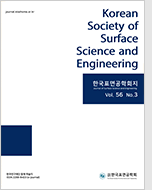
- Past Issues
- e-Submission
-

2021 Impact Factor 1.766
5-Year Impact Factor 1.674
Editorial Office
- +82-2-563-0935
- +82-2-558-2230
- submission@kssse.or.kr
- https://www.kssse.or.kr/

2021 Impact Factor 1.766
5-Year Impact Factor 1.674
The Korean Society of Surface Science and Engineering 2024;57(3):140-154. Published online: Jul, 8, 2024
DOI : 10.5695/JSSE.2024.57.3.140
As the trend towards miniaturization in semiconductor integration process, the limitations of interconnection metals such as copper, tungsten have become apparent, prompting research into the emergence of new materials like cobalt and emphasizing the importance of studying the corresponding process conditions. During the chemical mechanical polishing (CMP) process, corrosion inhibitors are added to the slurry, forming passivation layers on the cobalt surface, thereby playing a crucial role in controlling the dissolution rate of the metal surface, enhancing both removal rate and selectivity. This review investigates the understanding of the cobalt polishing process and examines the characteristics and behavior of corrosion inhibitors, a type of slurry additive, on the cobalt surface. Among the corrosion inhibitors examined, benzotriazole (BTA), 1,2,4-triazole (TAZ), and potassium oleate (PO) all improved surface characteristics through their interaction with cobalt. These findings provide important guidelines for selecting corrosion inhibitors to optimize CMP processes for cobalt-based semiconductor materials. Future research should explore combinations of various corrosion inhibitors and the development of new compounds to further enhance the efficiency of semiconductor processes.
Keywords Chemical Mechanical Polishing; Corrosion Inhibitor; Passivation layer; Slurry.